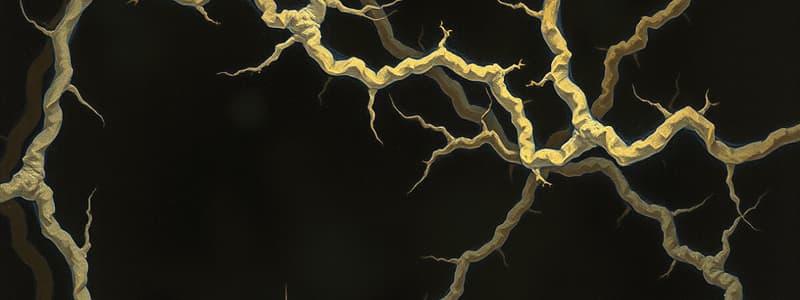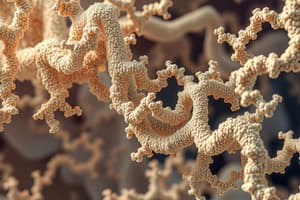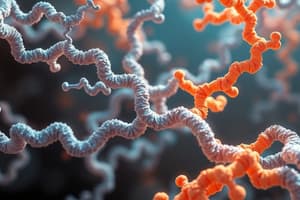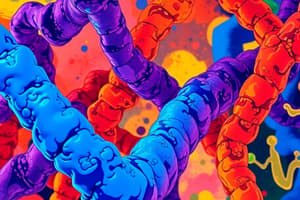Podcast
Questions and Answers
What is the primary function of fibrous proteins in the body?
What is the primary function of fibrous proteins in the body?
- Provide structural support for cells and tissues (correct)
- Transport nutrients throughout the body
- Store energy in cells
- Facilitate cellular communication
Which protein is the most abundant in the human body?
Which protein is the most abundant in the human body?
- Keratin
- Actin
- Elastin
- Collagen (correct)
What type of structure do collagen proteins primarily form?
What type of structure do collagen proteins primarily form?
- Double helix
- Single helix
- Triple helix (correct)
- Quadruple helix
Where can collagen and elastin be found in the human body?
Where can collagen and elastin be found in the human body?
Which option correctly describes the change in collagen and elastin levels with aging?
Which option correctly describes the change in collagen and elastin levels with aging?
Which characteristic is NOT associated with fibrous proteins?
Which characteristic is NOT associated with fibrous proteins?
What is the significance of hydroxylation in collagen structure?
What is the significance of hydroxylation in collagen structure?
What is the primary structural formation of collagen?
What is the primary structural formation of collagen?
Which type of collagen is characterized as fibril-forming?
Which type of collagen is characterized as fibril-forming?
What type of appearance do collagen fibers exhibit under an electron microscope?
What type of appearance do collagen fibers exhibit under an electron microscope?
Which function does dispersed collagen serve in the eye?
Which function does dispersed collagen serve in the eye?
The unique structure of collagen is primarily determined by what?
The unique structure of collagen is primarily determined by what?
How are the three polypeptide alpha chains in collagen held together?
How are the three polypeptide alpha chains in collagen held together?
What describes the arrangement of collagen fibers when they are stacked?
What describes the arrangement of collagen fibers when they are stacked?
What is the role of collagen types in the body?
What is the role of collagen types in the body?
What type of collagen organization is typical for providing structural support in tissues?
What type of collagen organization is typical for providing structural support in tissues?
What is the primary characteristic of Type I collagen?
What is the primary characteristic of Type I collagen?
Which type of collagen is primarily found in cartilage?
Which type of collagen is primarily found in cartilage?
Which of the following best describes the arrangement of collagen fibers in tendons?
Which of the following best describes the arrangement of collagen fibers in tendons?
What distinguishes Type III collagen from the other types?
What distinguishes Type III collagen from the other types?
How do network-forming collagens like Type IV differ from fibril-forming collagens?
How do network-forming collagens like Type IV differ from fibril-forming collagens?
Which type of collagen is associated with maintaining the structure of intervertebral discs?
Which type of collagen is associated with maintaining the structure of intervertebral discs?
What type of structural configuration allows bones to resist high mechanical shear?
What type of structural configuration allows bones to resist high mechanical shear?
Which collagen type is NOT predominantly associated with tensile strength?
Which collagen type is NOT predominantly associated with tensile strength?
What role does hydroxyproline play in collagen structure?
What role does hydroxyproline play in collagen structure?
Which enzyme is primarily responsible for hydroxylating proline residues in collagen synthesis?
Which enzyme is primarily responsible for hydroxylating proline residues in collagen synthesis?
What vitamin acts as a cofactor to prevent the oxidation of ferrous iron in the formation of collagen?
What vitamin acts as a cofactor to prevent the oxidation of ferrous iron in the formation of collagen?
Which of the following is NOT a requirement for the hydroxylation of proline residues?
Which of the following is NOT a requirement for the hydroxylation of proline residues?
How does the presence of hydroxyproline affect collagen stability?
How does the presence of hydroxyproline affect collagen stability?
What role does proline play in the structure of collagen?
What role does proline play in the structure of collagen?
In which part of the body is Type IV collagen primarily found?
In which part of the body is Type IV collagen primarily found?
Why is ascorbic acid important in collagen synthesis?
Why is ascorbic acid important in collagen synthesis?
What type of proteins provide structural support and have elongated shapes?
What type of proteins provide structural support and have elongated shapes?
Which of the following describes a property resulting from the unique structure of fibrous proteins?
Which of the following describes a property resulting from the unique structure of fibrous proteins?
What is the sequence pattern of collagen amino acids?
What is the sequence pattern of collagen amino acids?
Which of the following amino acids is commonly found in the hydroxylated form in collagen?
Which of the following amino acids is commonly found in the hydroxylated form in collagen?
What is the effect of insufficient ascorbic acid in the diet concerning collagen?
What is the effect of insufficient ascorbic acid in the diet concerning collagen?
What modification occurs during the process of hydroxylation in collagen?
What modification occurs during the process of hydroxylation in collagen?
Which carbohydrate is commonly attached during the glycosylation of collagen?
Which carbohydrate is commonly attached during the glycosylation of collagen?
How often does glycine appear in the polypeptide chain of collagen?
How often does glycine appear in the polypeptide chain of collagen?
Flashcards are hidden until you start studying
Study Notes
Overview of Fibrous Proteins
- Fibrous proteins are elongated and provide structural support to cells and tissues.
- Key examples include collagen and elastin, found in the extracellular matrix (ECM).
- Collagen comprises over 25 types and exhibits unique mechanical properties based on its structure, such as long fibers and helices.
Collagen
- The most abundant protein in the human body, crucial for various structural functions.
- Structure consists of a long, rigid triple helix formed by three polypeptide chains (α-chains) held together by hydrogen bonds.
- Notable types of collagen:
- Type I Collagen: Most prevalent; contains two alpha I chains and one alpha II chain. Found in tendons, corneas, and tissues requiring high tensile strength.
- Type II Collagen: Comprised of three alpha I chains. Primarily located in cartilage, intervertebral discs, and the vitreous body of the eye.
- Type III Collagen: Common in distensible tissues like blood vessels, skin, and muscle.
Types and Organization of Collagen
- Collagen types display various arrangements and properties:
- Dispersed: Provides gel-like support (e.g., vitreous humor).
- Stacked: Allows light transmission with minimal scattering (e.g., cornea).
- Bundled fibers: Offer high tensile strength (e.g., tendons).
- Right-angle arrangements: Resist mechanical shear (e.g., bone).
Structural Features
- Amino Acid Composition: Collagen typically features glycine, proline, and hydroxyproline or hydroxylysine in its sequences.
- Hydroxylation: Enhances stability; proline residues are modified, crucial for the formation of hydrogen bonds that stabilize the collagen structure.
- Glycosylation: Hydroxylysine residues undergo glycosylation with glucose and galactose prior to helix formation.
Importance of Vitamin C
- Vitamin C is essential as a cofactor in the hydroxylation process of proline, preventing instability in collagen structure due to improper hydrogen bonding.
- Lack of vitamin C can lead to weakened collagen and related health issues, such as fragile blood vessels and dental problems.
Checkpoint Overview
- Collagen consists of peptide sequences and forms helixes, with distinct types serving specific structural roles in various tissues.
- Fibrous proteins, such as collagen and alpha-keratin, are key components of the ECM, prevalent in skin and connective tissues.
Studying That Suits You
Use AI to generate personalized quizzes and flashcards to suit your learning preferences.




